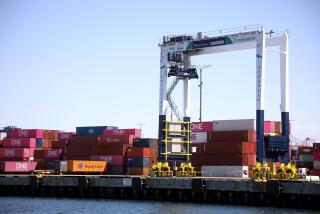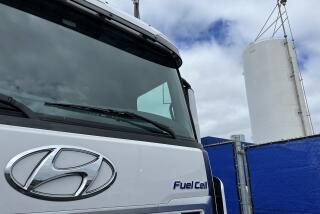Mercedes commits to hydrogen fuel with GLC F-Cell hybrid
- Share via
Mercedes-Benz is getting back into the hydrogen fuel cell game.
The German auto giant announced at the just-convened Frankfurt International Motor Show that it would begin selling the GLC F-Cell in the U.S. by late 2019.
Mercedes, which calls the hybrid SUV “the world’s first electric vehicle with fuel-cell/battery powertrain,” said the new F-Cell will have an all-electric battery range of 30 miles and a total hybrid range of 271 miles.
The German company joins a host of vehicle manufacturers that, in anticipation of tougher future European emissions standards, are moving away from diesel and gasoline engines and toward alternative fuel machines.
Last week, BMW and Jaguar Land Rover announced plans to ramp up production of electric vehicles, joining Volvo, Volkswagen and Ford in the group of automakers that have said they are anticipating the end of internal combustion engine production.
More recent reports say that the government in China, the world’s fastest growing automotive market, plans to ban sales of all gasoline- and diesel-powered cars and trucks.
The new Mercedes vehicle will be fitted with a 4.4-kilogram hydrogen fuel storage tank paired with a 13.8-kilowatt-hour lithium-ion battery.
The two power sources will push an electric motor capable of 147 kilowatts of thrust, Mercedes said. The F-Cell will be able to go as far as 30 miles on battery power alone before tapping the stored hydrogen for greater range.
The vehicles will make the equivalent of 197 horsepower and 258 pound-feet of torque, Mercedes said, and run at an electronically limited top speed of 99 miles per hour. The electric battery will be able to receive a full charge in about 1.5 hours.
Driving modes will allow the operator to run the car on hydrogen only, battery only, or in hybrid mode — making it possible for the hydrogen side to recharge the battery side, among other things.
The battery can also be recharged like a traditional plug-in, connected to a home wall plug or a commercial charging station.
The GLC F-Cell joins a small collection of hydrogen fuel cell cars on U.S. roads, among them Toyota’s Mirai, Honda’s Clarity and Hyundai’s Tucson.
Those cars, along with a previous Mercedes-Benz fuel cell B-Class vehicle, were powered by hydrogen fuel cell alone, and did not include an on-board battery capable of electric-only range.
They are popular among a small but passionate population of drivers because they run silently, do not produce toxic emissions and can be refueled in three to five minutes, just like gasoline-powered cars.
But sales and leases of those cars have been slow, in part because of the continued scarcity of hydrogen fueling stations.
Not all observers were applauding. Karl Brauer, senior analyst at Kelley Blue Book, while lauding Mercedes’ efforts to develop more alternative fuel vehicles, said the world still isn’t ready for widespread use of cars requiring hydrogen fuel.
“Hydrogen fuel cell cars are too expensive, and too limited in their functionality,” Brauer said. “They still can’t compete, largely because there aren’t enough stations.”
Mercedes did not provide information on pricing.







